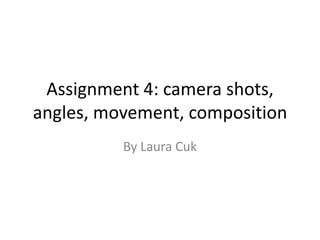
Assignment 4 media
- 1. Assignment 4: camera shots, angles, movement, composition By Laura Cuk
- 2. CAMERA SHOTS These are the different types of camera shots: -Establishing -Long -Two -Wide -Mid -Close-up -Extreme close-up -Over the shoulder -Overhead -POV (point of view) -Aerial
- 3. Establishing An establishing shot establishes the setting of a scene. An establishing shot is taken at ranges of distances, as if they were taken from a helicopter. You would usually see an establishing shot at the beginning of something.
- 4. Long A long shot is a shot that shows the framing of a character or subject of their body This shot is not necessarily used for only people. A long shot can be used for other things. An example of this would be a dinner table.
- 5. Two A two shot is very straightforward Usually done to show when two characters are communicating, conversing, interacting.
- 6. Wide • A wide shot is when you can view a large variety of information • A wide shot is also like a panoramic photograph
- 7. Mid/Medium A mid shot was commonly known as a medium shot. This camera shot is mostly used for dialogue Also a mid shot shows the framing of a character or subject of their torso and head, or their torso and their legs.
- 8. Close-up A close-up shot is the framing of a character or subject which shows a particular part of their body or object. An example would be a face, a nose, an eye etc. Close up is used to show more detail or info of a character or object.
- 9. Extreme close-up Extreme close-ups are a shot that is part of the body or face to show extreme detail
- 10. Over the shoulder This shot is taken over the back of a characters shoulder, emphasis on the ‘over the shoulder’ shot.
- 11. Overhead An overhead shot is the type of camera shot where the camera is placed above a characters head.
- 12. POV (point of view) A POV shot is a shot that shows a characters perspective. To do this particular shot, the camera will need to be placed on the face of the character, (better to be placed on the eyes) just like google glasses.
- 13. Aerial An aerial shot is quite similar to an overhead shot. This shot is taken from an overhead position. This shot may be similar to an overhead shot, but this shot is usually taken form a far distance. This is an example of an aerial shot. This picture is of the beginning of Eastenders. An aerial shot is like a bird view.
- 14. CAMERA ANGLES These are the three different types of camera angles: -Low -High -Canted/Oblique
- 15. Low A low angle is taken at a low level. Usually positioned on the ground. The purpose of a low angle is to enhance and make a character or subject look dominant in their role.
- 16. High This is an angle taken a high place that looks down on a character or subject. The purpose of a high angle is to make the character or subject appear smaller and vulnerable.
- 17. Canted/Oblique • This angle is an angle that makes whatever has been shot to look as if it was stewed or tilted.
- 18. CAMERA MOVEMENT There are nine different types of camera movement: -Pan -Tilt -Track -Zoom -Reverse zoom -Dolly -Crane -Stedicam -Vertigo
- 19. Pan A pan movement involves pivoting horizontally. This movement gives a panoramic view.
- 20. Tilt A tilt is when the camera is pivoting from up and down. A tilt movement reveals information.
- 21. Track Track is the movement of a camera that moves from side to side.
- 22. Zoom Zoom is when the camera features a zoom going in towards an object.
- 23. Reverse zoom Reverse zoom is the opposite of zoom. Reverse zoom is also called a zoom out.
- 24. Dolly A dolly movement is where the camera moves in and out or backwards and forwards.
- 25. Crane When the camera is on a crane An example of this would be the way the camera moves across the stage and audience like in the x-factor.
- 26. Stedicam A stedicam is a stabilizing mount for a camera which mechanically isolates the operators movement from the camera. A stedicam is often used in sports or for high action.
- 27. Vertigo This is the movement which is zooming and dollying at the same time.
- 28. COMPOSITION There are eight different types of composition: -Balance -Depth of field -Shallow focus -Deep focus -Symmetry -Asymmetry -Rule of thirds -Focus Pulls
- 29. Balance • When things are arranged elements so that no one part of a work overpowers, or seems heavier than other part.
- 30. Depth of field • Is a distance of what is on focus.
- 31. Shallow focus Shallow focus is a photographic and cinematographic technique. This movement is used to emphasise one thing over another thing.
- 32. Deep focus This is when everything is in focus. This is when you can see the foreground, background and midground
- 33. Symmetry When the shot is equally symmetrical or balanced on both sides.
- 34. Asymmetry Is the opposite of symmetry. It is when the shot is equally asymmetrical or unbalanced on both sides. This type of composition is often used in filming to show disorder, chaos.
- 35. Rule of thirds This is a composition rule used for the visual arts, such as paintings, photography, film and design. Rule of thirds promotes interests, tension, energy in a composition. This is taken without rule of thirds. This is taken with rule of thirds.
- 36. Focus pulls This type of composition is usually very hard to compose. It is when you pull or change the focus of something.